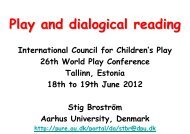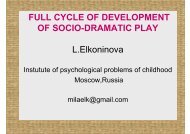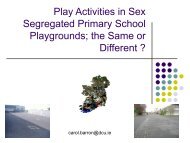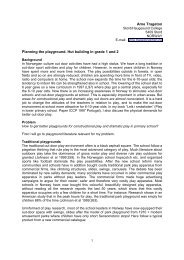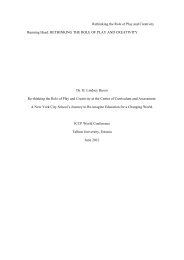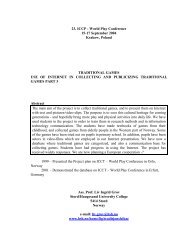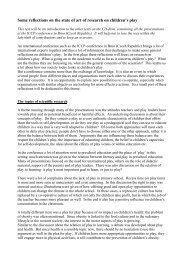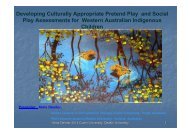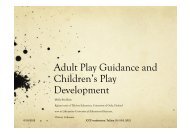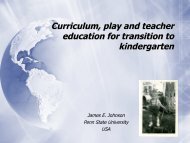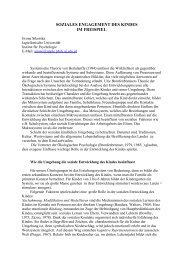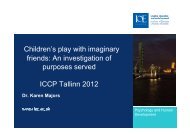Edutainment or Entertainment - International Council for Children's ...
Edutainment or Entertainment - International Council for Children's ...
Edutainment or Entertainment - International Council for Children's ...
You also want an ePaper? Increase the reach of your titles
YUMPU automatically turns print PDFs into web optimized ePapers that Google loves.
<strong>Edutainment</strong> <strong>or</strong> <strong>Entertainment</strong><br />
Education Possibilities of Didactic Games in Science Education<br />
Jiří Němec and Josef Trna, Czech Republic<br />
1. <strong>Edutainment</strong> as a topical social phenomenon<br />
1.1 Introduction<br />
<strong>Edutainment</strong> is a distinctive f<strong>or</strong>m of entertainment that enables the participants to be<br />
educated (e.g. get new inf<strong>or</strong>mation from various fields of our life) <strong>or</strong> even brought up (their<br />
postures, values and behavioural patterns could be influenced). The education in these cases<br />
takes place and the participants hardly notice the process itself. There are many new means<br />
used in the process – experiential pedagogy, medial pedagogy, IT virtual reality, etc.<br />
As it might be obvious from the term itself, the w<strong>or</strong>d is a compound of two distinctive<br />
w<strong>or</strong>ds: education and entertainment. At first sight, the two hardly compatible terms f<strong>or</strong>m a<br />
new field of educational reality, in which the teacher does not perf<strong>or</strong>m the key role - to be the<br />
educat<strong>or</strong> - but also the whole set of psychological and methodological means that are linked to<br />
the new inf<strong>or</strong>mation and communicative technologies and other heavily spread mass media.<br />
Let us have a look at the possibilities and the challenges that the edutainment provides us in<br />
the field of didactic games and simple experiments based on the experiments of the natural<br />
sciences, using simple experiments.<br />
1.2 Hist<strong>or</strong>y of the entertaining education<br />
The idea of entertaining education is not that new in the hist<strong>or</strong>y of education science.<br />
Let us remember some philosophers and teachers and we will immediately visualize the<br />
concepts and their creat<strong>or</strong>s that supp<strong>or</strong>ted the idea of joy, entertainment, illustrative methods<br />
and etc., just to make the process of learning f<strong>or</strong> the children pleasant. It was obvious in the<br />
era of Renaissance and Enlightenment that the attitude f<strong>or</strong> the pupils is changed; it is the play<br />
and other educational methods that are being focused on at the time. They aim to activate the<br />
individuality and make the process of education m<strong>or</strong>e human compared to the Middle Ages<br />
philosophy of education. (Němec, 2002).<br />
First of all, Czech educat<strong>or</strong> J. A. Komenský (1592 – 1670) who is often associated<br />
with the term "school as play" belongs to the pool of significant thinkers. Komenský made a<br />
play part of his pedagogical system and allocated some time in the delivering of the topics<br />
when teaching, he managed to structure the play acc<strong>or</strong>ding to the age and set up the rules how<br />
to use them. He refers to the play in his whole w<strong>or</strong>k and in fact he understands the play in two<br />
meanings: Play as a theatre perf<strong>or</strong>mance that focuses, f<strong>or</strong> example, on dramatization of a<br />
hist<strong>or</strong>ical event <strong>or</strong> other educational material and play as a didactic "joyful" method that<br />
should help to educate body <strong>or</strong> mind. And it is the "joy of play" that underlined and<br />
emphasized now and as we can experience, it is becoming one of the motifs that brings us to<br />
amusements centres, educational institutions museums and in fact the involvement in the<br />
plays themselves.
1.3 B<strong>or</strong>dering lines of the education, entertainment and a game, edutainment as an<br />
educational concepts<br />
To set up the precise b<strong>or</strong>ders of what is the entertaining education and what is the<br />
education using the features of entertainment (edutainment) is difficult; mainly because the<br />
play itself contains the features of entertainment and education. <strong>Edutainment</strong> is very broad in<br />
the sense of the w<strong>or</strong>d and could be characterised by many structure activities. The basic<br />
principles are common f<strong>or</strong> both the categ<strong>or</strong>ies; they provide users with the entertainment and<br />
education. The edutainment activities are less strict in their structures and are not directly<br />
linked with the rules and ideas of the particular game. Bef<strong>or</strong>e the game the participants have<br />
to get acquainted with the rules, its sense and also the casts of the characters participating in<br />
the game. The edutainment activities are entered directly, being motivated only by the wish to<br />
enjoy and try and only in the process itself, the participants think about the process and realize<br />
what they have just experienced and thus, unconsciously, are being educated. The following<br />
list of characteristics (Němec, 2004) focuses on the precise definition of pedagogical<br />
definition of play and at the same time it shows the fields of intersection with entertaining<br />
education.<br />
ENTERTAINMENT<br />
Amusements and joy are the main motifs f<strong>or</strong> people to go and enjoy the activities. Longish<br />
and sometimes b<strong>or</strong>ing lessons could be replaced by plays and primarily do not have to be just<br />
entertaining but could focus on the exercising the new knowledge in a merry and easy way.<br />
GAME/PLAY<br />
Game/play could be characterized as a free activity of a group <strong>or</strong> an individual person (child<br />
<strong>or</strong> adult) limited by a certain time period. The topic of the game/play play sources in the<br />
interests of the group and the meaning is to be found directly in the game/play <strong>or</strong> is outside<br />
the play (f<strong>or</strong> example motif <strong>or</strong> target). The game/play is the medium to obtain specific needs<br />
<strong>or</strong> meet different targets. The game/play is different from the everyday life by its distinctive<br />
rules and also by the inside plays features, such as competing <strong>or</strong> the role identification. The<br />
game/play brings the satisfaction of the needs, enjoyment, entertainment and also some<br />
knowledge and experience f<strong>or</strong> the players.<br />
EXPERIENTING<br />
Game/play is classified (together with edutainment) as one part of the experiential pedagogy.<br />
If the participant is ready to accept the rules, then it is him <strong>or</strong> her who starts to be the creat<strong>or</strong><br />
“new themes” and there are many activities that are experienced directly without any in<br />
between link. Experience (based on own and unique experiencing) create the solid base f<strong>or</strong> a<br />
possible change of the personality <strong>or</strong> possible fixation of new knowledge <strong>or</strong> skill.<br />
MEANING OF LIFE<br />
During the pre school age, sometimes even at younger school age, the game/play is the unique<br />
natural activity that is necessary f<strong>or</strong> the personality development in full harmony. This is the<br />
activity that is mostly enjoy by children and creates the basic pillars of the sense of life.<br />
Professional literature states many causal cases of deprived children who could not experience<br />
the play at their childhood.<br />
SOCIAL ROLE<br />
If we enter the w<strong>or</strong>ld of play <strong>or</strong> interactive entertainment, we usually accept the role which is<br />
described by a set of rules. The process is similar to the theatre character described in a script<br />
<strong>or</strong> even life role, which is described by the social and m<strong>or</strong>al rules. And likewise the same<br />
Hamlets in the theatre perf<strong>or</strong>mance using the same lines express different ideas and provide<br />
topical messages based on the context of the period, could players experience the role<br />
individually and uniquely.
SIMULATION<br />
Each place is in its nature simulative as it always pretends <strong>or</strong> imitate. The base of the<br />
simulation (especially in so called simulative games) is to create a pattern that represents the<br />
real life (problem) and is able to react to the players’ and <strong>or</strong>ganizers’ behaviour. Players in the<br />
"play area" could encounter situations that are quite unique in a real life. The base of the<br />
unique matter lies in a certain danger that is brought by the situations <strong>or</strong> potentially could<br />
bring.<br />
COGNITION AND SELF COGNITION<br />
Plays and activities based on the entertaining education enable the teachers to learn m<strong>or</strong>e<br />
about their pupils and in a different way than from the classroom <strong>or</strong> any other usual habitat.<br />
Also they provide the feedback f<strong>or</strong> the participant about his <strong>or</strong> her own behaviour (see<br />
simulation).<br />
1.4 <strong>Edutainment</strong> in the mirr<strong>or</strong> of the w<strong>or</strong>ld today<br />
The present phenomena of today is the increasing c<strong>or</strong>relation between the level of<br />
education and the expectation f<strong>or</strong> the quality of entertainment which is meaningful and still is<br />
not considered as a waste of time. A lot of amusements centres and big leisure centres (f<strong>or</strong><br />
example in USA, they are known f<strong>or</strong> their long tradition) list in the attraction also the<br />
activities that should educate the visit<strong>or</strong>s. The traditional museums and also public<br />
institutions, which might sometimes imply to be b<strong>or</strong>ing and dull to visit, inc<strong>or</strong>p<strong>or</strong>ate into their<br />
curat<strong>or</strong>'s visions features of enjoyments and play.<br />
<strong>Edutainment</strong> features are to be found also in many different fields of a man’s<br />
activities, not primarily at schools <strong>or</strong> educational institutions. We can find some in so called<br />
brand lands – company parks that are developed by the big companies and international<br />
concerns. Probably the most well known park of the kind is Legoland. The <strong>or</strong>iginal idea of a<br />
garden that would serve as a place to exhibit the toys produced of lego was changed into a<br />
great entertaining and educational park, that was open already in 1932. Compared to the<br />
American Disneyland it does not provide only entertainment but in fact, it represents wide and<br />
popular construction kit project that is popular with kids and teens and f<strong>or</strong> certainly the kits<br />
are also of educative meaning as well.<br />
1.5 <strong>Edutainment</strong> in educational institutions<br />
The education reality is becoming also interesting from the point of view of pay back<br />
economy and marketing possibilities and theref<strong>or</strong>e it is offering m<strong>or</strong>e and m<strong>or</strong>e examples of<br />
media publishers and toy manufactures. At the moment the principles of edutainment are<br />
developed on the following fields.<br />
Museums and children museums<br />
As already mentioned above, all the institutions are getting into the lab<strong>or</strong>at<strong>or</strong>ies of knowledge<br />
where it is not only allowed to touch the objects, if possible, but also give things a try and try<br />
to understand complex physical and naturals processes. Distinctive type of museums in the<br />
range are so called children museums (Jůva, 2004, 195) that could be characterized by<br />
creating the space f<strong>or</strong> children learning that sources from the play and adventure, from<br />
experience and discoveries, they are social and they have the features of entertainment. The<br />
supp<strong>or</strong>t f<strong>or</strong> the heuristic teaching is already stated interaction of the exhibits.<br />
Leisure time and ecological education centres, zoos
At the same time as the museum undergo the changes, there are also other institutions that are<br />
no longer focused on children as the only target group but they widen the offer also f<strong>or</strong> the<br />
adults and are ready to prepare f<strong>or</strong> the demanded target group (families socially handicapped<br />
groups of children, etc.). Entertaining and educative programmes in zoos use f<strong>or</strong> example the<br />
direct contact with animals in the runs and wherever this is possible; children can feed the<br />
goats <strong>or</strong> ride the ponies. Ecological centres <strong>or</strong>ganize a lot of courses based on the<br />
constructivist principles. Children themselves make their bread to get acquainted with the<br />
process starting from the mill to the baking were able to imagine all the accompanying<br />
activities.<br />
Inf<strong>or</strong>mation and communication technologies (ICT)<br />
ICT belong to the most spread phenomena in the field of edutainment. The development of<br />
new technologies and their vast (and theref<strong>or</strong>e cheap) production brought a new phenomena;<br />
entertainment at your home PC <strong>or</strong> any other equipment (play station, video games. etc.). And<br />
in the whole section of the industry there is a new branch that concentrates directly into the<br />
usage of computer games at the education – so called Game Based Learning – GBP. Recently,<br />
we had been experiencing mostly the development of multimedia products (encyclopaedias,<br />
dictionaries, games) distributed using the CD ROM and DVD media (e.g. off line versions).<br />
But now we have been confronted (in the context of the high capacity netw<strong>or</strong>ks) with<br />
development of similar internet based applications. That resulted in the creation of well<br />
collab<strong>or</strong>ated and complex games. Players share the virtual space of the Internet and they can<br />
compete and still cooperate when gaining the territ<strong>or</strong>ies <strong>or</strong> fighting the same enemy and all<br />
that could be done without leaving the room. Multimedia play and also encyclopaedias and all<br />
other didactic means use all the latest technical and also psychological aspects in the<br />
communication with the user. The example to illustrate the latest development follows:<br />
Interaction: virtual system is controlled by the user and acc<strong>or</strong>ding to the programmed <strong>or</strong><br />
individually decided alg<strong>or</strong>ithm the user gets the answer – feedback. Player gets the<br />
inf<strong>or</strong>mation all the time “about his <strong>or</strong> her behaviour” in the system and he <strong>or</strong> she can change<br />
the strategy of decision making.<br />
Multimedia: all the content is delivered via m<strong>or</strong>e f<strong>or</strong>ms, if possible (texts, spoken w<strong>or</strong>ds,<br />
music, pictures, film) and during the process as many cognitive processes of the person as<br />
possible is involved.<br />
Individual and social: all the systems are sub<strong>or</strong>dinated to the individual rate of the user, they<br />
react as he <strong>or</strong> she likes. On one side they isolate the user in the interactively limited space<br />
(user, system, me and PC and so on), on the other hand they enable to create new social<br />
relationships that are not based on the interaction of face to face type, but on sharing the<br />
common virtual space via a communication media (Internet, mobile phones and so on.) using<br />
the new communication application (chat, e-mail, e-discussions and conferences etc.).<br />
Simulation and approaching the reality: Programmes based on the simulation, simulating the<br />
real situation <strong>or</strong> a certain process are very popular mainly thanks to various simulat<strong>or</strong>s<br />
(aircraft control, driving cars etc.). But there are also some m<strong>or</strong>e complex game systems such<br />
as weather f<strong>or</strong>ecasting, prediction of a social behaviour of a group of people (f<strong>or</strong> example<br />
games with a social topics, games simulating stock exchange, city management – quite well<br />
spread game SimCity etc.). Participants in fact change the initial variable values (variables)<br />
that are processed acc<strong>or</strong>ding to a settled alg<strong>or</strong>ithm (complex lists are provided by the<br />
software) and acc<strong>or</strong>ding to the output values it is decided about further steps.<br />
Mass media<br />
Even bef<strong>or</strong>e the rapid development of film and TV there were some features of edutainment<br />
discovered in fairy tales and fables and st<strong>or</strong>ytelling that mirr<strong>or</strong> the experience of the mankind<br />
and are distributed by the w<strong>or</strong>d of mouth. They are especially fables and fairy tales that
provide m<strong>or</strong>al messages that might make the base f<strong>or</strong> the character development of the kids in<br />
certain cultural context of the society. Hand in hand with the development of the TV<br />
broadcasting in the second half of the 20 th century and with the development of the cable TV<br />
the society experiences the spread of the entreating educative series f<strong>or</strong> children, youth and<br />
adults. We can list some educational series of the BBC <strong>or</strong> documentaries from the Discovery<br />
Channel, Animal Planet <strong>or</strong> Spectrum TVs. <strong>Edutainment</strong> is also linked with the wide spread<br />
TV series (soap operas). That kind of series is based on simple st<strong>or</strong>y line and human and<br />
family relationships are developed then. In many case these could be characterised by<br />
oversimplified didactics focused on certain target group (maternity leave women, students,<br />
etc.). Using the so called emotional realism the series gain regular public that identify<br />
themselves with the characters in the series during the broadcasting. The phenomena could be<br />
positively used at the education and influencing the values of people – f<strong>or</strong> example in the case<br />
of planning the families, contraception pills usage, obesity prevention <strong>or</strong> drug usage.<br />
<strong>Edutainment</strong> as part of the broadcasting could be the vital element in the education of millions<br />
of people in the developing countries, such as HIV prevention. Some USA universities deal<br />
with similar projects together with Centre f<strong>or</strong> Disease Control.<br />
2. <strong>Edutainment</strong> as an innovative science teaching technique<br />
2.1 <strong>Edutainment</strong> in the education<br />
The imp<strong>or</strong>tance of edutainment activities is largely accepted by teachers who have<br />
already been projecting its aspects in the process of education. Even though they have the<br />
possibilities to visit different exhibitions, see different companies and etc. to provide the<br />
students with the picture of the real w<strong>or</strong>ld, they still could realize various entertaining<br />
activities directly when teaching. In the paragraphs bellow, we publish several hints how to<br />
use didactic game in the science teaching.<br />
2.2 <strong>Edutainment</strong> in the science teaching<br />
There are a lot of distinctive teachers when teaching science at different levels of the<br />
educational system. But now and then, it is the idea of “scientific approach” that makes the<br />
teachers to emphasize the “encyclopaedia” point of view and very abstract teaching. The<br />
science teachers are in fact since the very beginning of their subject studies are set up to be<br />
afraid to use the teaching methods and techniques that might doubt the "serious" points of<br />
view in the natural sciences research in the f<strong>or</strong>m of principal laws. That results in the fact that<br />
the teachers underestimate the phase of motivation, they do not unify the teaching with the<br />
practical aspects of everyday life, they might refuse to use humour in the teaching and etc.<br />
Often they defend the point that teaching sciences is mainly serious mental and cognitive<br />
activity and the emotional point of view should not be present when teaching. Students might<br />
thus be distracted and de-motivated and block their future studies of the natural sciences.<br />
Natural sciences subject didactics teachers are very well aware of the decrease of the<br />
popularity and negative attitude of pupils and theref<strong>or</strong>e they search f<strong>or</strong> new methods, f<strong>or</strong>ms<br />
and means that might change the tendency. One of the possibilities seems to be the usage of<br />
the didactic games and plays as described in the principles of the edutainment.
3. Didactic games and simple experiments in science education<br />
3.1 Didactic science game<br />
<strong>Edutainment</strong>, didactic games and experiments at school<br />
The position of didactic games at education is quite distinctive. They are often used as a<br />
review tool f<strong>or</strong> practising knowledge and skills; sometimes they are used to motivate the<br />
pupils. But examples of didactics games explaining the basic physical phenomena are still<br />
quite rare. The whole process of acquiring the new knowledge and skills using these didactic<br />
games will be dealt with in details bellow.<br />
Introduction to the problem situation – change of the pupil’s role<br />
The teacher presents the pupils with a problem situation. The problem situation could be<br />
defined as a certain situations which could be characterized by the acquaintance of the<br />
entering condition but with no idea about the final level. (What will happen if ...?) At this<br />
moment we usually gain the attention of the pupil who will change his <strong>or</strong> her role from “pupil<br />
– listener” into a “pupil – creat<strong>or</strong>”.<br />
Expectations<br />
At the level the pupil is asked to make a guess based on his knowledge and gained experience<br />
how the experiment will finish. The experiment is created in a way that the result is different<br />
from the expectations of the pupils. All the games based on simple experiments with uncertain<br />
result that do not fit within the expectations of the pupils destroy the misconception and<br />
motivate pupils to learn m<strong>or</strong>e and bring next questions. (How is that possible?) The search f<strong>or</strong><br />
the c<strong>or</strong>rect answer moves the pupil to higher level of understandings.<br />
Interaction and feedback (action & reaction)<br />
Uncertain result games are accompanied by interaction based on the chronological sequence<br />
of single steps. The experimenting pupil makes a step as instructed by the teacher (f<strong>or</strong><br />
example put the coin into a bottle full of water (action) and immediately he <strong>or</strong> she gets the<br />
feedback (reaction): the surface increases but so far the water does not spill out. This<br />
knowledge will bring the pupil to the next step: putting next coins into the vessel. The pupil<br />
modifies the expectations and builds up new knowledge, f<strong>or</strong> example on the nature of fluids.<br />
Motivation<br />
The motivation of the pupil is changed from the external (“You should learn something<br />
interesting from physics.”) into internal (“I want to know how that will come out.”). The<br />
whole process is accompanied by the emotions of the pupil – education by experiencing (by<br />
tension, uncertainty). The didactic game as a part of edutainment activities should never be<br />
primarily considered by pupil as a process of education. Psycho-didactic problem is how to<br />
link the game with the education, taking into account the fact that the education is expected by<br />
the pupils. It is necessary to have the pupils involved spontaneously, almost instinctively. The<br />
the<strong>or</strong>y of motivation deals with the aspects. Acc<strong>or</strong>ding to the classification of the needs<br />
provided by Maslow, the didactic game could induce some of the needs. They are:<br />
(a) Sensual and muscle activities (unpremeditated needs)<br />
(b) Recognition and prestige in the team<br />
(c) Self realization in the game and enjoyment<br />
(d) Cognition<br />
Didactic game is in the education presented in the f<strong>or</strong>m of impulse (internal motive) <strong>or</strong><br />
incentive (external motive) and induces the needs listed above by mixing them (Trna, Trnová,<br />
2006a). There are several types of didactic games differentiated from that particular point of<br />
view:<br />
(1) Play with a toy
(2) Competitive game<br />
(3) Problem game<br />
(4) Project game<br />
There are no strict b<strong>or</strong>ders between these games. A lot of competitive games include also the<br />
features of a problem game.<br />
3.2 Simple experiment and didactic science game<br />
The science education is well suited f<strong>or</strong> the application of didactic games that are<br />
based on simple experiments. And those didactic games will be discussed later.<br />
Simple experiment is an experiment which has several features. These are: (Trna, Trnová,<br />
2006b):<br />
• Transparency of an exposition of the principle of the natural phenomenon with the<br />
suppression of the side effects that might occur at the experiment.<br />
• Quality of the experiment when all useless measurement does not occupy the<br />
attention needed f<strong>or</strong> the principle of the natural phenomenon.<br />
• Easy to do – when the experiment could be experienced almost by all senses and is<br />
realized by the pupils, regardless if at class <strong>or</strong> when doing homew<strong>or</strong>k.<br />
• Problems – all the cognitive needs are encouraged and the follow up activity in the<br />
search f<strong>or</strong> solution are both involved. Extreme extent of those needs is always raised<br />
by paradox experiments and tricks.<br />
• Price – the low price is also imp<strong>or</strong>tant when talking about the usage of limited<br />
financial resources.<br />
• Development of the pupil’s skills and development of his <strong>or</strong> her creativity.<br />
The usage of simple aids that are the pupils familiar with from their everyday life is<br />
also very imp<strong>or</strong>tant from the pedagogical, psychological and constructivism point of view.<br />
We have been using the pupils' preconception. An imp<strong>or</strong>tant part of the simple experiment is<br />
also the possibility to make simulations when, if the parameters are changed, one can tell the<br />
principle of the natural phenomenon and also find the relations among the quantities<br />
describing the phenomenon. Simple experiments with simple teaching aids could be used f<strong>or</strong><br />
most of the natural sciences didactic games.<br />
3.3 Examples of didactic science games<br />
Play with toy<br />
The toy in the role of a simple teaching aid stimulates the need to have sense and muscle<br />
activities, to say the least, the play is then unconsciousness to its maximal limit. So the<br />
relaxation function of the play is really remarkable. There are many toys manufactured<br />
commercially all round the w<strong>or</strong>ld. The toy is an object which displays a feature that is<br />
remarkably emphasized - elasticity, colour, distinctive behaviour, etc.<br />
Spring ball:<br />
The spring ball is a very elastic rubber ball that, after hitting the flo<strong>or</strong>, jumps really high. The<br />
phenomenon to understand is the elasticity and the rule of the energy conservation.<br />
Balance:
The objects with a lower centre of mass do not capsize. It is recommended to use the<br />
commercial toys, oval covers <strong>or</strong> polystyrene eggs. The phenomenon to understand is the<br />
balance of the objects.<br />
Walking hedgehog:<br />
Wooden hedgehog (<strong>or</strong> any other animal) with a functional leg moves down on the inclined<br />
plane. The phenomenon to understand is the gravitation.<br />
Glockenspiel:<br />
A wooden tree has got spiral wooden leaves that are shivered by a ball that is dropped on<br />
those leaves. The phenomenon to understand is the source of sound, the strike tone and<br />
gravitation.<br />
Competitive game<br />
When <strong>or</strong>ganizing the competitive game, we mainly stimulate the social need to win in the<br />
competition of the others. Simple experiment is placed within the framew<strong>or</strong>k of the<br />
competitive game in the f<strong>or</strong>m of a central object. The competition itself focuses on the most<br />
effective demonstration of the experiment.<br />
Soap bubbles:<br />
Pupils <strong>or</strong> representatives of the teams try to do their best to make the biggest bubble using the<br />
straw and the soap fluid. The game is easy to alternate by asking pupils to have the bubble of<br />
certain diameter floating as long as possible. The phenomenon to understand is the surface<br />
tension when making the bubbles.<br />
Liquid surface:<br />
Pupils <strong>or</strong> representatives of the teams try to put objects (coins, stones, balls) into a container<br />
filled with water. The task is to use as many objects as possible without spilling the water. The<br />
phenomenon to understand is the surface tension in the fluids.<br />
Problem game<br />
When <strong>or</strong>ganizing the problem game, the point is to stimulate the need to solve problems.<br />
Simple experiment is once again the central object that contains the problem itself. The game<br />
can take the f<strong>or</strong>m of a puzzle, trick explanation, paradox, etc.<br />
Ball in a glass:<br />
A small ball is placed into a conical glass. The task is to get the ball out and not to touch the<br />
ball and also not to overturn the glass. The solution is to make the ball rotate and the spiral<br />
movement will drive the ball out of the glass. The phenomenon to understand is the<br />
centrifugal f<strong>or</strong>ce.<br />
Strong paper:<br />
Put a strip of paper over the neck of the empty glass. The strip of paper is supposed to hold<br />
the coin from falling into the glass. The paper will not make it. The problem task is possible to<br />
be solved by folding the paper in a concertina style and only then it can hold several coins.<br />
The phenomenon to understand is the solidity and flexibility of objects.<br />
Project game<br />
The highest level of the problem task is a project. The project game should stimulate several<br />
needs; f<strong>or</strong> example, how to solve the problems <strong>or</strong> find one's position in the team. From the<br />
point of view of the time, it is easier to create sh<strong>or</strong>ter perspective project games.
Ships:<br />
The products of the game are the ships made by the pupils of paper, skewers, strings, plastic<br />
films, polystyrene and etc. The vessels are later presented in the class parade and are<br />
demonstrated in the tank with water. That is about two hour project game. The phenomenon<br />
to understand is the Archimedes Principle and the principle of floating and the balance.<br />
Molecules:<br />
Pupils create incidental shapes out of the balls and linking sticks that are supposed to<br />
represent molecules. It is also possible to use the school construction kit of molecules. The<br />
results are presented at a class exhibition where the pupils try with the help of teachers to<br />
identify the compounds and guess the possibility of real existence of the molecule. That is<br />
about two hour project game and it is recommended to set up the rules f<strong>or</strong> the number of<br />
balls-atoms and etc. The phenomenon to understand is the chemical bond and their<br />
principles.<br />
Summary<br />
<strong>Edutainment</strong> <strong>or</strong> entertaining education is a new field of education reality. The<br />
evaluation of edutainment projects must be based on qualified monit<strong>or</strong>ing of the ratio between<br />
the educational and entertaining activities related to the target group. Not all the products of<br />
the entertaining industry available on the market contain enough educational features. Often<br />
the entertaining part prevails which is – based on the marketing point of view - m<strong>or</strong>e<br />
attractive. A lot of meaningless computer games that are based only on the number of soldiers<br />
shot is to be presented as a proof of the tendency as well as the wide spread infotainment in<br />
the mass media based on tabloid and sensationalist news broadcasting.<br />
Acknowledgements<br />
The paper was created in the project “Special Needs of Pupils in Context with<br />
Framew<strong>or</strong>k Educational Programme f<strong>or</strong> Primary Education“(Research intent<br />
MSM0021622443).<br />
References<br />
Asociace mladých debrujárů. http://www.debrujar.cz/php/doc/stanovy2006.doc<br />
BRDIČKA, B.: Role internetu ve vzdělávání. Praha, KU PdF 2003.<br />
Burmester, M; Gerhard, D. Thissen, F.: Digital Games Based Learning. Karlsruhe,<br />
Universitetsverllag Karlsruhe, 2005. ISBN 3-86644-010-3.<br />
HEWITT, I. E.: <strong>Edutainment</strong>: How to Teach Language With Fun & Games.Delta Systems Co<br />
Inc; 1998.<br />
MACAULAY, D.: Mamutí kniha techniky. Praha, Slováry, 1996.<br />
MACAULAY, D.: Jak věci pracují. [CD ROM] v. 2.0, Praha, BSP, 1997. Inf<strong>or</strong>mace o CD<br />
jsou dostupné z .
MANN WILLIAM P.: <strong>Edutainment</strong> Comes Alive! (Book and Cd-Rom) Sams; Bk&CD Rom,<br />
1994.<br />
MAŠEK, J.; MICHALÍK, P.; VRBÍK, V. Otevřené technologie ve výuce. Plzeň, Západočeská<br />
univerzita, 2004.<br />
NĚMEC, J.: Od prožívání k požitkářství. Výchovné funkce hry a její proměny v hist<strong>or</strong>ických<br />
koncepcích pedagogiky. Brno, Paido 2002.<br />
NĚMEC, J.: S hrou na cestě za tvořivostí. Poznámky k rozvoji tvořivosti žáků. Brno, Paido<br />
2004.<br />
RŮŽIČKA, O. Internet pro učitele. Praha, Computer Press, 2001.<br />
SINGHAL, A.; Cody M. J.; Rogers E. M.; Sabino, M.: <strong>Entertainment</strong>-Education and Social<br />
Change: Hist<strong>or</strong>y, Research, and Praktice. Lawrence Erlbaum Associates, 2003.<br />
SOUKUP, B.: Soukup Graphic Programming systems. Stránky jsou dostupné z:<br />
http://www.sgp.cz<br />
TRNA, J., TRNOVÁ, E. Cognitive Motivation in Science Teacher Training. In Science and<br />
Technology Education f<strong>or</strong> a Diverse W<strong>or</strong>ld. Lublin (Poland): M. Curie-Sklodovska university<br />
press, 2006. p. 491-498. ISBN 83-227-2497-7<br />
TRNA, J., TRNOVÁ, E. Everyday Living and Safe Living in Simple Science Experiments. In<br />
Science and Technology Education in the Service of Humankind. 12th IOSTE Symposium.<br />
Penang (Malaysia): School of Educational Studies, University Science Malaysia, Penang,<br />
2006. p. 556-561. ISBN 983-2700-39-6<br />
Key w<strong>or</strong>ds:<br />
Brand lands, education, edutainment, Game Based Learning - GBL, play, mass media,<br />
infotainment, inf<strong>or</strong>mation technologies, interaction, media, multimedia, attitudes,<br />
programming, experience, simulation, education, leisure time education, teaching,<br />
entertainment, experiential pedagogy, feedback, simple experiment, didactic game.
<strong>Edutainment</strong> <strong>or</strong><br />
<strong>Entertainment</strong><br />
Education Possibilities of Didactic Games in<br />
Science Education<br />
Jiří Němec<br />
• Department of social Education<br />
• Faculty of Education<br />
• Masaryk university, Brno<br />
• Czech Republic<br />
Josef Trna<br />
• Department of Physics<br />
• Faculty of Education<br />
• Masaryk university, Brno<br />
• Czech Republic
EDUTAINMENT<br />
What does the w<strong>or</strong>d mean?<br />
• the w<strong>or</strong>d is a compound of two<br />
distinctive w<strong>or</strong>ds<br />
• EDUCATION and<br />
• ENTERTAINMENT<br />
• At first sight, the two hardly<br />
compatible terms f<strong>or</strong>m a new field of<br />
educational reality
Definition of <strong>Edutainment</strong><br />
• <strong>Edutainment</strong> is a distinctive f<strong>or</strong>m of<br />
entertainment that enables the participants to be<br />
educated<br />
• e.g. get new inf<strong>or</strong>mation from various fields of<br />
our life<br />
• <strong>or</strong> even brought up<br />
• their attitude, values and behavioural patterns<br />
could be influenced. Education in these cases<br />
takes place without the participant noticing the<br />
process itself. There are many new means used in<br />
the process – experiential pedagogy, medial<br />
pedagogy, IT virtual reality etc.
Hist<strong>or</strong>y of the<br />
Entertaining Education<br />
• The idea of entertaining education is<br />
not that new in the hist<strong>or</strong>y of education<br />
science.<br />
• the concepts and their creat<strong>or</strong>s<br />
supp<strong>or</strong>ted the<br />
• idea of joy,<br />
• entertainment,<br />
• play<br />
• illustrative methods and etc.,<br />
•just to make the process of learning f<strong>or</strong><br />
the children pleasant
SCHOOL as PLAY<br />
• J. A. Komenský (1592 – 1670)<br />
• First of all Czech educat<strong>or</strong> who is often<br />
associated with the term "school as play" belongs<br />
to the pool of significant thinkers
SCHOOL as PLAY<br />
• J. A. Komenský (1592 – 1670)<br />
• refers to the play in his whole w<strong>or</strong>k and in<br />
fact he understands the play in two<br />
meanings:<br />
• 1) play as a theatre perf<strong>or</strong>mance that<br />
focuses, f<strong>or</strong> example, on dramatization of<br />
a hist<strong>or</strong>ical event <strong>or</strong> other educational<br />
material<br />
• 2) and play as a didactic "joyful" method<br />
that should help to educate body <strong>or</strong> mind -<br />
"joy of play"
<strong>Edutainment</strong> as an<br />
Educational Concepts<br />
• characteristics focus on the precise definition of<br />
pedagogical definition of play and at the same<br />
time it shows the fields of intersection with<br />
entertaining education<br />
• ENTERTAINMENT - amusements<br />
and joy are the main motifs why<br />
people go f<strong>or</strong> the activities. B<strong>or</strong>ing<br />
lessons could be replaced by plays
PLAY<br />
• Free activity of a group <strong>or</strong> an individual<br />
person (child <strong>or</strong> adult) limited by a certain<br />
time period. The topic of the play sources<br />
in the interests of the group and the<br />
meaning is to be found directly in the play<br />
<strong>or</strong> is outside the play (f<strong>or</strong> example<br />
incentive <strong>or</strong> target). The play brings the<br />
satisfaction of the needs, enjoyment,<br />
entertainment and also some knowledge<br />
and experience f<strong>or</strong> the players.
EXPERIENTING<br />
• Play is classified (together with<br />
edutainment) as one part of the<br />
experiential pedagogy<br />
• Experience, based on own and unique<br />
experiencing create the solid base<br />
f<strong>or</strong> a possible change of the<br />
personality
MEANING OF LIFE<br />
• During the pre school<br />
age, sometimes even at<br />
younger school age, the<br />
play is the unique natural<br />
activity that is necessary<br />
f<strong>or</strong> the personality<br />
development in full<br />
harmony
SOCIAL ROLE<br />
• If we enter the w<strong>or</strong>ld of play<br />
<strong>or</strong> interactive entertainment,<br />
we usually accept the role<br />
which is described by defined<br />
sets of rules
SIMULATION<br />
• Each place is in its nature<br />
simulative as it always<br />
pretends <strong>or</strong> imitate. The<br />
base of the simulation<br />
(especially in so called<br />
simulative games) is to<br />
create a pattern that<br />
represents the real life
COGNITION AND<br />
SELF COGNITION<br />
Plays enable the teachers to learn<br />
m<strong>or</strong>e about their pupils and in a<br />
different way than from the<br />
classroom <strong>or</strong> any other usual<br />
habitat.
<strong>Edutainment</strong><br />
in the mirr<strong>or</strong><br />
of the w<strong>or</strong>ld<br />
today
• <strong>Edutainment</strong> in educational institutions<br />
• Museums and children museums<br />
• Leisure time and ecological education<br />
centres, zoos<br />
• Inf<strong>or</strong>mation and communication<br />
technologies<br />
• Mass media<br />
• School - didactic games and<br />
experiments at school
Didactic science games<br />
• Didactic science game is edutainment.<br />
• Didactic science game is motivational impulse and/<strong>or</strong><br />
incentive.<br />
• Induced needs (in combination):<br />
- sensual and mot<strong>or</strong>ic activity<br />
- credit and prestige in society<br />
- self fulfilment in game and entertainment<br />
- cognition<br />
• Kinds of didactic science games (no exact limits):<br />
• Game with a toy<br />
• Competitive game<br />
• Problem game<br />
• Project game
Hands-on experiments and<br />
didactic science game<br />
Hands-on experiment and his characteristics:<br />
• Transparency<br />
• Quality<br />
• Undemanding technical realization<br />
• Problem<br />
• Inexpensivity<br />
• Development of students‘ experimental skills and<br />
creativity.<br />
Hands-on experiments with everyday objects cam be used in<br />
didactic games.
Play with a toy<br />
• The toy is an object with the accented<br />
characteristic – elasticity, colour, special<br />
behaviour etc.<br />
• The toy in the f<strong>or</strong>m of hands-on experiment<br />
induces the need of sensual and mot<strong>or</strong>ic activity.<br />
• Relaxation role of the didactic game with a toy is<br />
high-level.<br />
• A lot of toys are commercially produced.
Competitive game<br />
• The competition is aimed on highlevel<br />
realisation of experiment.<br />
• The competitive game induces<br />
the social need of credit and<br />
prestige in society (to win).<br />
• Hands-on experiment is insert<br />
into competitive game as the<br />
central object the game runs on.
Problem play<br />
• The problem has the f<strong>or</strong>m of brain-teaser,<br />
explanation of trick and/<strong>or</strong> paradox etc.<br />
• Problem play induces cognitive need to solve a<br />
problem.<br />
• Hands-on experiment is the central object with<br />
the problem.
Project play<br />
• The project is the complex problem with<br />
outcomes and team-w<strong>or</strong>k.<br />
• Project play induces cognitive need to solve a<br />
problem and to assert oneself in a team.<br />
• Sh<strong>or</strong>t-time projects is needed to create by the<br />
time limit.<br />
• A hands-on experiment and/<strong>or</strong> aids are outcomes<br />
of the project.
Thanks a lot f<strong>or</strong> your attention



